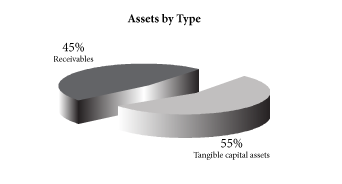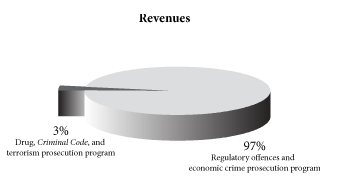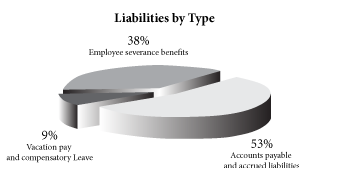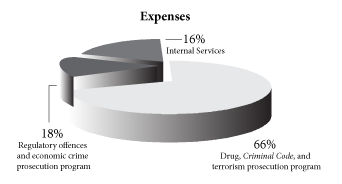Common menu bar links
Breadcrumb Trail
ARCHIVED - Public Prosecution Service of Canada - Report
 This page has been archived.
This page has been archived.
Archived Content
Information identified as archived on the Web is for reference, research or recordkeeping purposes. It has not been altered or updated after the date of archiving. Web pages that are archived on the Web are not subject to the Government of Canada Web Standards. As per the Communications Policy of the Government of Canada, you can request alternate formats on the "Contact Us" page.
SECTION III: SUPPLEMENTARY INFORMATION
3.1 Financial Highlights
The financial highlights presented within this DPR are intended to serve as a general overview of the PPSC’s financial position and operations. The PPSC’s financial statements are available on its website at: http://www.ppsc-sppc.gc.ca/eng/pub/index.html
| Condensed Statement of Financial Position as at March 31, 2010 |
% Change | 2008-09 | 2009-10 |
|---|---|---|---|
| Total Assets | -11 % | 11,420 | 10,205 |
| Total Liabilities | 6% | 38,552 | 40,993 |
| Total Equity | 13% | - 27,132 | - 30,788 |
| Total | -11% | 11,420 | 10,205 |
| Condensed Statement of Operations for the year ended March 31, 2010 |
% Change | 2008-09 | 2009-10 |
|---|---|---|---|
| Total Expenses | 12% | 155,771 | 174,024 |
| Total Revenues | 5% | 12,529 | 13,157 |
| Net Cost of Operations | 12% | 143,242 | 160,867 |
 |
Total assets were $10.2 million at the end of 2009-10, a decrease of $1.2 million over the previous year’s assets of $11.4 million. Receivables and tangible capital assets represented the bulk of the PPSC’s assets. |
 |
Total revenues increased by 5% from 2008-09. All the revenues stemmed from the recovery of costs from federal investigative agencies for legal advice and litigation support and the prosecution of federal offences to protect the environment, natural resources, as well as economic and social health. |
 |
Total liabilities were $41 million at the end of 2009-10, an increase of $2.4 million over the previous year’s liabilities of $38.6 million. Accounts payable, accrued liabilities and employee severance benefits represented most of the PPSC’s liabilities. |
 |
Total expenses for the PPSC were $174.0 million9 in 2009-10, which increased by 12% over the previous year. The majority of funds, $115.5 million or 66%, were spent in the prosecution of drug, organized crime and Criminal Code offences and included the increase in agent fee rates. The expenses in this area increased by 17% over 2008-09. |
3.2 List of Tables
All electronic supplementary information tables listed in the 2009–10 DPR can be found on the Treasury Board of Canada Secretariat’s website at
http://www.tbs-sct.gc.ca/dpr-rmr/st-ts-eng.asp.
Horizontal Initiatives, including the following:
- National Anti-Drug Strategy, led by the Department of Justice Canada
- Integrated Market Enforcement Teams Initiative, led by the Department of Public Safety
- Federal Tobacco Control Strategy, led by Health Canada
- Integrated Proceeds of Crime, led by the Department of Public Safety
3.3 Other Items of Interest
The following PPSC publications can be found at: http://www.ppsc-sppc.gc.ca/eng/pub/index.html
- The Federal Prosecution Service Deskbook
- Public Prosecution Service of Canada Annual Report 2009-2010
- Public Prosecution Service of Canada Annual Report on the Privacy Act 2009-2010
- Public Prosecution Service of Canada Annual Report on the Access to Information Act 2009-2010
1The PPSC was created on December 12, 2006, when the Director of Public Prosecutions Act, Part 3 of the Federal Accountability Act, came into force.
2The planned FTE's included 143 vacant positions, the majority of which were not staffed due to a realignment of position levels with available salary resources, employee turnover, and delays in hiring.
3Realignment to revised Program Activity Architecture.
4Commencing in the 2009-10 Estimates cycle, the resources for the Internal Services program activity are displayed separately from other program activities; they are no longer distributed among the remaining program activities, as was the case in previous Main Estimates. This has affected the comparability of spending and FTE information by program activity between fiscal years.
5A case is decided on its merits when a judge or jury determines the guilt or innocence of an accused person after a trial. A case is also considered to be decided on its merits where a judge determines after a guilty plea that a conviction is appropriate, or where a Crown prosecutor stays or withdraws a charge as a result of an assessment that the case does not meet the test for prosecution or as result of a plea of guilty being entered to a serious charge rendering proceedings on a less serious charge redundant.
6Cases not decided on merit are those that are stayed or quashed by the Court, and for which, as a result, there is no outcome decided by a judge or jury based on the evidence of guilt or innocence. A judicially imposed stay will generally mean discontinuance or permanent suspension of the proceedings.
7The operational priority for prosecution-related advice provided during investigations is primarily focused on highly complex and mega cases and cases involving a high degree of legal risk.
8In Budget 2007, the Government, while recognizing the value of the Integrated Market Enforcement Teams (IMETs) in investigating complex capital markets fraud acknowledged that the results achieved to date suggested that there is room for improvement. A senior expert advisor, Mr. Nick Le Pan (former Federal Superintendent of Financial Institutions) was appointed to advise the RCMP and federal partner departments, and to help develop and guide the implementation of a plan to improve the effectiveness of IMETs. Mr. Le Pan’s report was submitted to the RCMP Commissioner in October 2007 and is available at: http://www.rcmp-grc.gc.ca/imet-eipmf/pdf/report-rapport-lepan2007-eng.pdf.
9Total Expenses are higher than Actual Spending because they include non-cash expenses like amortization, allowances, and accrual expenditures.
